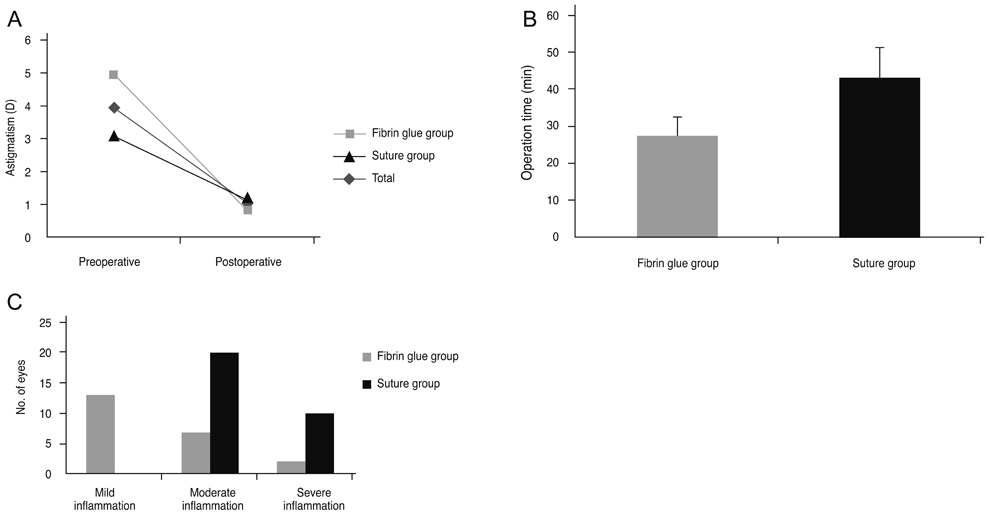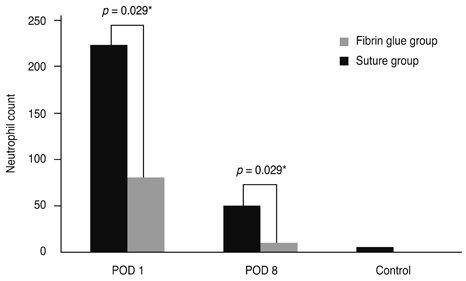Korean J Ophthalmol.
2012 Dec;26(6):407-413. 10.3341/kjo.2012.26.6.407.
A Comparative Study of the Effect of Fibrin Glue versus Sutures on Clinical Outcome in Patients Undergoing Pterygium Excision and Conjunctival Autografts
- Affiliations
-
- 1Department of Ophthalmology, Seoul National University College of Medicine, Seoul, Korea. kmk9@snu.ac.kr
- 2Laboratory of Corneal Regenerative Medicine and Ocular Immunology, Seoul Artificial Eye Center, Seoul National University Hospital Clinical Research Institute, Seoul, Korea.
- KMID: 1499677
- DOI: http://doi.org/10.3341/kjo.2012.26.6.407
Abstract
- PURPOSE
To compare the effect of using fibrin glue or 10-0 nylon sutures on the clinical outcome of patients undergoing pterygium excision and conjunctival autografting.
METHODS
We retrospectively reviewed the medical records of 52 eyes from 46 patients who underwent pterygium excision and conjunctival autografting and were followed up for more than 3 months. The operation duration, postoperative inflammation, complications, and recurrence rates were compared between groups of 20 patients (22 eyes) for whom fibrin glue was used (fibrin glue group) and 26 patients (30 eyes) for whom suturing was performed with 10-0 nylon (suture group) in pterygium excision and conjunctival autografting.
RESULTS
The operation duration was 27.71 (5.22) minutes in the fibrin glue group and 43.30 (8.18) minutes in the suture group (p = 0.000). Seven days after the operation, the fibrin glue group showed milder conjunctival inflammation than the suture group (p = 0.000). Postoperative complications and corneal recurrence rates were not statistically different between the two groups.
CONCLUSIONS
The use of fibrin glue in pterygium excision with conjunctival autografting is likely to be a more effective, safer procedure than suturing.
MeSH Terms
-
Adult
Aged
Aged, 80 and over
Conjunctiva/*transplantation
Female
Fibrin Tissue Adhesive/*pharmacology
Follow-Up Studies
Humans
Male
Middle Aged
Patient Satisfaction
Pterygium/*surgery
Retrospective Studies
Suture Techniques/*instrumentation
*Sutures
Time Factors
Tissue Adhesives/pharmacology
Transplantation, Autologous
Fibrin Tissue Adhesive
Tissue Adhesives
Figure
Reference
-
1. Moran DJ, Hollows FC. Pterygium and ultraviolet radiation: a positive correlation. Br J Ophthalmol. 1984. 68:343–346.2. Nakaishi H, Yamamoto M, Ishida M, et al. Pingueculae and pterygia in motorcycle policemen. Ind Health. 1997. 35:325–329.3. Norn M, Franck C. Long-term changes in the outer part of the eye in welders. Prevalence of spheroid degeneration, pinguecula, pterygium, and corneal cicatrices. Acta Ophthalmol (Copenh). 1991. 69:382–386.4. Prabhasawat P, Barton K, Burkett G, Tseng SC. Comparison of conjunctival autografts, amniotic membrane grafts, and primary closure for pterygium excision. Ophthalmology. 1997. 104:974–985.5. Koranyi G, Seregard S, Kopp ED. Cut and paste: a no suture, small incision approach to pterygium surgery. Br J Ophthalmol. 2004. 88:911–914.6. Uy HS, Reyes JM, Flores JD, Lim-Bon-Siong R. Comparison of fibrin glue and sutures for attaching conjunctival autografts after pterygium excision. Ophthalmology. 2005. 112:667–671.7. Bahar I, Weinberger D, Gaton DD, Avisar R. Fibrin glue versus vicryl sutures for primary conjunctival closure in pterygium surgery: long-term results. Curr Eye Res. 2007. 32:399–405.8. Karalezli A, Kucukerdonmez C, Akova YA, et al. Fibrin glue versus sutures for conjunctival autografting in pterygium surgery: a prospective comparative study. Br J Ophthalmol. 2008. 92:1206–1210.9. Srinivasan S, Dollin M, McAllum P, et al. Fibrin glue versus sutures for attaching the conjunctival autograft in pterygium surgery: a prospective observer masked clinical trial. Br J Ophthalmol. 2009. 93:215–218.10. Tan DT, Chee SP, Dear KB, Lim AS. Effect of pterygium morphology on pterygium recurrence in a controlled trial comparing conjunctival autografting with bare sclera excision. Arch Ophthalmol. 1997. 115:1235–1240.11. Paris Fdos S, de Farias CC, Melo GB, et al. Postoperative subconjunctival corticosteroid injection to prevent pterygium recurrence. Cornea. 2008. 27:406–410.12. Ang LP, Chua JL, Tan DT. Current concepts and techniques in pterygium treatment. Curr Opin Ophthalmol. 2007. 18:308–313.13. Sanchez-Thorin JC, Rocha G, Yelin JB. Meta-analysis on the recurrence rates after bare sclera resection with and without mitomycin C use and conjunctival autograft placement in surgery for primary pterygium. Br J Ophthalmol. 1998. 82:661–665.14. Talu H, Tasindi E, Ciftci F, Yildiz TF. Excimer laser phototherapeutic keratectomy for recurrent pterygium. J Cataract Refract Surg. 1998. 24:1326–1332.15. Amano S, Motoyama Y, Oshika T, et al. Comparative study of intraoperative mitomycin C and beta irradiation in pterygium surgery. Br J Ophthalmol. 2000. 84:618–621.16. Shaffrey CI, Spotnitz WD, Shaffrey ME, Jane JA. Neurosurgical applications of fibrin glue: augmentation of dural closure in 134 patients. Neurosurgery. 1990. 26:207–210.17. Gosain AK, Lyon VB. Plastic Surgery Educational Foundation DATA Committee. The current status of tissue glues: part II. For adhesion of soft tissues. Plast Reconstr Surg. 2002. 110:1581–1584.18. Bertrand B, Doyen A, Eloy P. Triosite implants and fibrin glue in the treatment of atrophic rhinitis: technique and results. Laryngoscope. 1996. 106(5 Pt 1):652–657.19. Dadeya S, Ms K. Strabismus surgery: fibrin glue versus vicryl for conjunctival closure. Acta Ophthalmol Scand. 2001. 79:515–517.20. Lagoutte FM, Gauthier L, Comte PR. A fibrin sealant for perforated and preperforated corneal ulcers. Br J Ophthalmol. 1989. 73:757–761.21. Hick S, Demers PE, Brunette I, et al. Amniotic membrane transplantation and fibrin glue in the management of corneal ulcers and perforations: a review of 33 cases. Cornea. 2005. 24:369–377.22. Ozdamar Y, Mutevelli S, Han U, et al. A comparative study of tissue glue and vicryl suture for closing limbal-conjunctival autografts and histologic evaluation after pterygium excision. Cornea. 2008. 27:552–558.23. Hall RC, Logan AJ, Wells AP. Comparison of fibrin glue with sutures for pterygium excision surgery with conjunctival autografts. Clin Experiment Ophthalmol. 2009. 37:584–589.24. Marticorena J, Rodriguez-Ares MT, Tourino R, et al. Pterygium surgery: conjunctival autograft using a fibrin adhesive. Cornea. 2006. 25:34–36.25. Alvarenga LS. Comments on using fibrin glue in pterygium surgery. Br J Ophthalmol. 2005. 89:392.26. Chan SM, Boisjoly H. Advances in the use of adhesives in ophthalmology. Curr Opin Ophthalmol. 2004. 15:305–310.27. Hino M, Ishiko O, Honda KI, et al. Transmission of symptomatic parvovirus B19 infection by fibrin sealant used during surgery. Br J Haematol. 2000. 108:194–195.28. Koranyi G, Seregard S, Kopp ED. The cut-and-paste method for primary pterygium surgery: long-term follow-up. Acta Ophthalmol Scand. 2005. 83:298–301.29. Freitas TM, Miguel MC, Silveira EJ, et al. Assessment of angiogenic markers in oral hemangiomas and pyogenic granulomas. Exp Mol Pathol. 2005. 79:79–85.30. Yuan K, Wing LY, Lin MT. Pathogenetic roles of angiogenic factors in pyogenic granulomas in pregnancy are modulated by female sex hormones. J Periodontol. 2002. 73:701–708.
- Full Text Links
- Actions
-
Cited
- CITED
-
- Close
- Share
- Similar articles
-
- The Use of Fibrin Glue for Conjunctival Autotransplantation in Pterygium
- Clinical Outcomes between Amniotic Membrane Transplantation and Conjunctival Autograft Using Fibrin Glue for Pterygium Surgery
- Pterygium Surgery: Wide Excision with Amniotic Membrane Transplantation using Fibrin Glue
- Recurrence Rates of Amniotic Membrane Transplantation, Conjunctival Autograft and Conjunctivolimbal Autograft in Primary Pterygium
- Clinical Outcomes after Use of Fibrin Glue Using a Modified Mini-flap Technique for Pterygium Surgery





